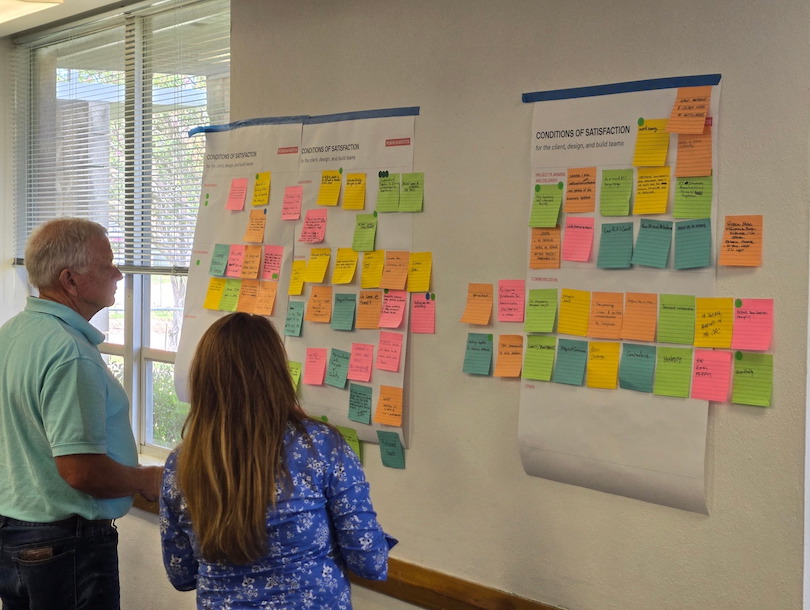How can you succeed if you cannot define success?
Budget, schedule, and quality are hailed as the “big three” primary performance indicators in construction projects, and they’re certainly important, but do they really demonstrate whether the project was successful? Fortunately, there’s a framework to ensure a more collaborative and unified construction experience, and that’s where Conditions of Satisfaction (CoS) come into play.
The CoS process is designed to ensure that all stakeholders, including the client, design team, and key trade contractors, establish shared project goals and objectives from the outset. Projects that have an intentional focus on collaboration, alignment of interests, organizational integration, and consensus on priorities outperform traditionally delivered projects.
For many practicing Lean construction, Conditions of Satisfaction are foundational to project management. Sometimes, however, we can become complacent in routine. We go through the motions, check the boxes, and forget that the CoS is intended to guide our future decision-making. The result is a list of generic requirements that doesn’t encourage us to improve. Anything that isn’t pushing us forward is holding us back.
To set our sights beyond the checklist and develop guiding principles for our projects that align, empower, and engage project leaders, we must avoid the three CoS complacency traps.
“Just Focus on the Schedule”
One of our favorite ways to begin a Conditions of Satisfaction alignment meeting is to ask, “What is important to you? You can’t say budget, quality, safety, or schedule.”
Sometimes, we’re met with disbelief: “But schedule is the most important thing!”
Maybe, but no one starts a construction project just to meet a schedule. We encourage everyone in the session to take a step back and dig a little deeper by asking:
2. What constraints do you anticipate?
3. How would you define success?
We can get this project finished within the budget, within the schedule, and built with great quality, but those factors say little about the process and the long-term goals for the project.
Ask yourself: How can your project contribute to the long-term vitality of your community? This allows everyone to understand the “why.” Why is this project being built and why is it important to the people in the room?
“Is This Really Worth It?”
Imagine you’re explaining the CoS process and you scan the room. You see people nodding, and the look in their eyes says they understand — they’re onboard. Just as you’re inviting participants to share their priorities for the project, someone standing at the back of the room raises his hand.
“This sounds great, but shouldn’t we focus on more pressing items?” He says and shrugs. “I mean, this could really slow us down.”
Every group has a skeptic and, believe it or not, that’s healthy. It means you’re creating an environment where people feel comfortable speaking up and asking questions. Beyond that, the speed of decision making is a valid concern in construction projects. Pausing to ask every team member about every decision would be time prohibitive, but what the skeptic is missing is that the Conditions of Satisfaction are proactive consensus-building measures. Instead of slowing decisions later, CoS speed them along.
By establishing common priorities and language, setting guardrails, and force-ranking the resulting information, the team creates a roadmap for more efficient future decision making.
“It’s Done — File It Away”
It’s best to establish the project’s CoS as early as possible, but if you’re not looking at them again until the end of the project, you’ve fallen into trap #3: Set it and forget it.
Project delivery teams should schedule opportunities to measure progress and collect feedback on the CoS. Some of these mechanisms may include:
- Meeting regularly with project health checks to ensure continued alignment.
- Onboarding new team members and capturing their measures of success.
- Adjusting the CoS based on changes in project scope.
- Ensuring you’re viewing the CoS as something that can be improved.
So, What Should We Do?
Like all Lean processes, CoS is at its best when applied alongside the PDCA process. In the “plan” phase, focus on establishing the culture and reaching consensus on where you’re going. Next, in the “do” phase, develop a shared vision, cultivate trust, and improve team efficiency. When you reach the “check” phase, ensure there is a mechanism in place to review progress often. Lastly, be open to change and prepare to adjust anything that’s not working for the team.
A mentor once said, “Never be too busy to improve.” When developing Conditions of Satisfaction, a shortcut in the near term can become a long-term disservice. The CoS is only one tool in a suite of many to make your project the best it can be, but it’s one of the most impactful, if you commit to being honest and vulnerable in defining what it means to be successful.
 Jennifer Lacy (Jen)
Jennifer Lacy (Jen) Kyle Davis
Kyle Davis
